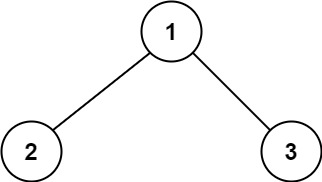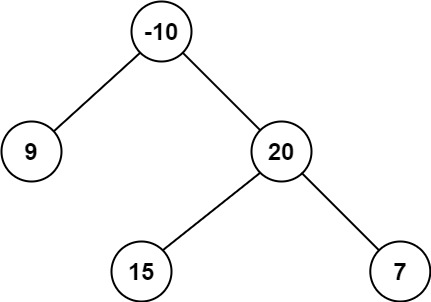124.binary-tree-maximum-path-sum
Statement
Metadata
- Link: 二叉树中的最大路径和
- Difficulty: Hard
- Tag:
树深度优先搜索动态规划二叉树
路径 被定义为一条从树中任意节点出发,沿父节点-子节点连接,达到任意节点的序列。同一个节点在一条路径序列中 至多出现一次 。该路径 至少包含一个 节点,且不一定经过根节点。
路径和 是路径中各节点值的总和。
给你一个二叉树的根节点 root ,返回其 最大路径和 。
示例 1:

输入:root = [1,2,3]
输出:6
解释:最优路径是 2 -> 1 -> 3 ,路径和为 2 + 1 + 3 = 6示例 2:

输入:root = [-10,9,20,null,null,15,7]
输出:42
解释:最优路径是 15 -> 20 -> 7 ,路径和为 15 + 20 + 7 = 42
提示:
- 树中节点数目范围是
[1, 3 * 104] -1000 <= Node.val <= 1000
Metadata
- Link: Binary Tree Maximum Path Sum
- Difficulty: Hard
- Tag:
TreeDepth-First SearchDynamic ProgrammingBinary Tree
A path in a binary tree is a sequence of nodes where each pair of adjacent nodes in the sequence has an edge connecting them. A node can only appear in the sequence at most once. Note that the path does not need to pass through the root.
The path sum of a path is the sum of the node's values in the path.
Given the root of a binary tree, return the maximum path sum of any non-empty path.
Example 1:

Input: root = [1,2,3]
Output: 6
Explanation: The optimal path is 2 -> 1 -> 3 with a path sum of 2 + 1 + 3 = 6.
Example 2:

Input: root = [-10,9,20,null,null,15,7]
Output: 42
Explanation: The optimal path is 15 -> 20 -> 7 with a path sum of 15 + 20 + 7 = 42.
Constraints:
- The number of nodes in the tree is in the range
[1, 3 * 104]. -1000 <= Node.val <= 1000
Solution
# Definition for a binary tree node.
# class TreeNode:
# def __init__(self, val=0, left=None, right=None):
# self.val = val
# self.left = left
# self.right = right
from typing import Optional
class Solution:
res = -1000
def dfs(self, root: TreeNode) -> int:
if not root:
return 0
left = self.dfs(root.left)
right = self.dfs(root.right)
val = root.val
self.res = max(self.res, left + right + val,
left + val, right + val, val)
return max(val, left + val, right + val)
def maxPathSum(self, root: Optional[TreeNode]) -> int:
self.dfs(root)
return self.res
最后更新: October 11, 2023